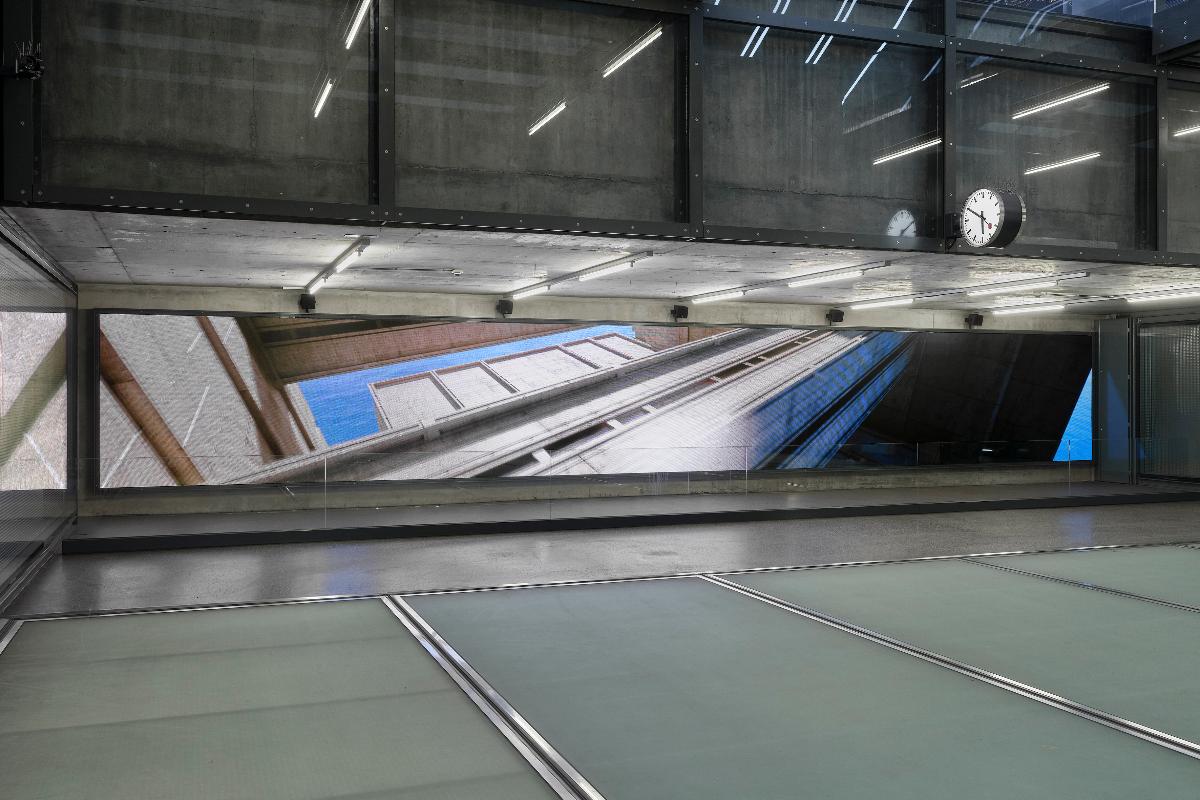Œuvre coproduite par le Fonds cantonal d'art contemporain et le Centre d'Art Contemporain Genève, dans le cadre de la Biennale de l'Image en Mouvement et du programme MIRE. Diffusée sur l'écran de la gare de Champel de janvier à mai 2024.
Lawrence Lek est né en 1982 à Francfort-sur-le-Main, dans une famille d'origine sino-malaisienne. Il a étudié l'architecture dans différentes universités : au Trinity College de Cambridge, à l'Architectural Association de Londres, et à la Cooper Union de New York. Artiste multimédia, cinéaste et musicien, il produit ses œuvres par le biais d'ordinateurs, avec des technologies de réalité virtuelle et d'imagerie générée qui lui permettent de produire des environnements digitaux complexes. La formation en architecture de Lek, ainsi que ses années de jeunesse passées en Asie à une époque où les villes se développaient de manière effrénée, sont pour beaucoup dans sa manière de créer des espaces virtuels: la qualité du lieu et de l'architecture y tiennent une place primordiale. Par sa pratique artistique, Lawrence Lek interroge les questions éthiques que soulève l'utilisation des nouvelles technologies, ainsi que leur impact sur la cité et les thématiques du changement climatique, du racisme ou de la mondialisation. Ses œuvres ont été montrées dans des expositions à travers l'Asie et l'Europe, comme à la LAS Art Foundation à Berlin en 2023, ou au Center for Contemporary Arts de Prague en 2019.
La vidéo Empty Rider donne à voir le début d'un procès dans une cour de justice, où est jugée une entité d'intelligence artificielle prenant les traits d'une voiture autonome. En effet, cette dernière s'est rebellée contre sa créatrice, la docteure Lin, provoquant un accident alors qu'elle la conduisait vers un rendez-vous. Dans la mise en scène de ce procès fictif, les problématiques liées à la considération juridique, aux droits et aux obligations des intelligences artificielles, à l'éthique de la surveillance, ainsi qu'au futur de la "smart city" sont en jeu. Le public est transporté dans un futur proche, dans la ville de SimBeijing, une "smart city" dans laquelle l'intelligence artificielle est ultra développée, mais qu'elle peine à dompter. La vidéo montre le lieu du jugement, un tribunal monumental au centre duquel est exhibée la voiture accusée. Des voix résonnent dans la salle: celle du juge, puis celles des avocats impliqués dans l'affaire. L'absence de toute présence humaine dans le tribunal est révélatrice : elle pose la question de la place de l'humain dans les débats sur la législation des intelligences artificielles et augure les discordes à ce propos, qui seront forcément nombreuses dans les prochaines années et auxquelles nos sociétés doivent se préparer.
Lawrence Lek was born in 1982 in Frankfurt am Main, into a family of Chinese-Malaysian origin. He studied architecture at Trinity College, Cambridge, the Architectural Association in London and the Cooper Union in New York. A multimedia artist, filmmaker and musician, he produces his works using computers, virtual reality technologies and generated imagery to create complex digital environments. Lek's training in architecture, as well as the years he spent growing up in Asia at a time when cities were developing at breakneck speed, have had a major influence on the way he creates virtual spaces: the quality of the place and the architecture are of paramount importance. Through his artistic practice, Lawrence Lek questions the ethical issues raised by the use of new technologies, as well as their impact on the city and the themes of climate change, racism and globalisation. His work has been shown in exhibitions across Asia and Europe, including at the LAS Art Foundation in Berlin in 2023, and at the Center for Contemporary Arts in Prague in 2019.
The Empty Rider video shows the start of a trial in a court of law, where an artificial intelligence entity taking the form of an autonomous car is on trial. The car rebelled against its creator, Dr Lin, causing an accident while driving it to an appointment. The staging of this fictional trial brings into play issues relating to legal considerations, the rights and obligations of artificial intelligence, the ethics of surveillance and the future of the smart city. The audience is transported into the near future, to SimBeijing, a smart city in which artificial intelligence is highly developed but struggling to master itself. The video shows the scene of the trial, a monumental court in the centre of which the accused car is displayed. Voices echo around the room: that of the judge, then those of the lawyers involved in the case. The absence of any human presence in the courtroom is revealing: it raises the question of the place of humans in the debates on the legislation of artificial intelligences and foreshadows the discord on this subject that is bound to abound in the coming years and for which our societies must be prepared.
